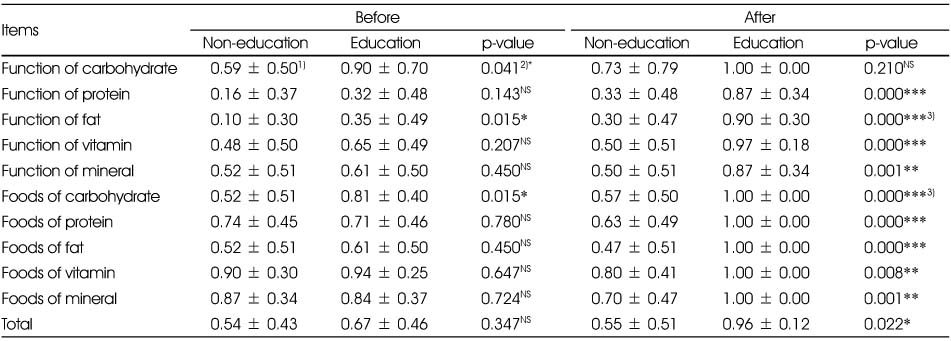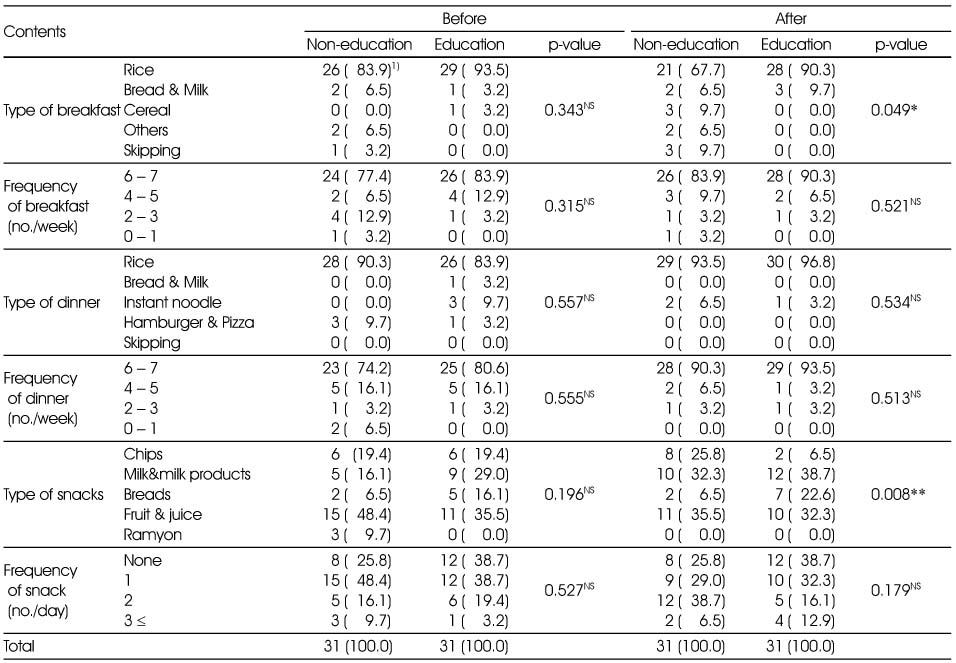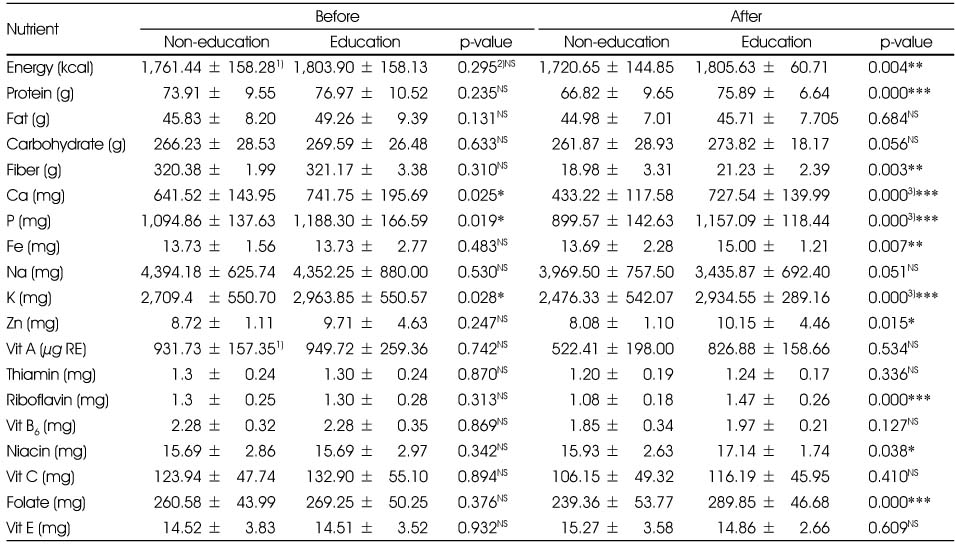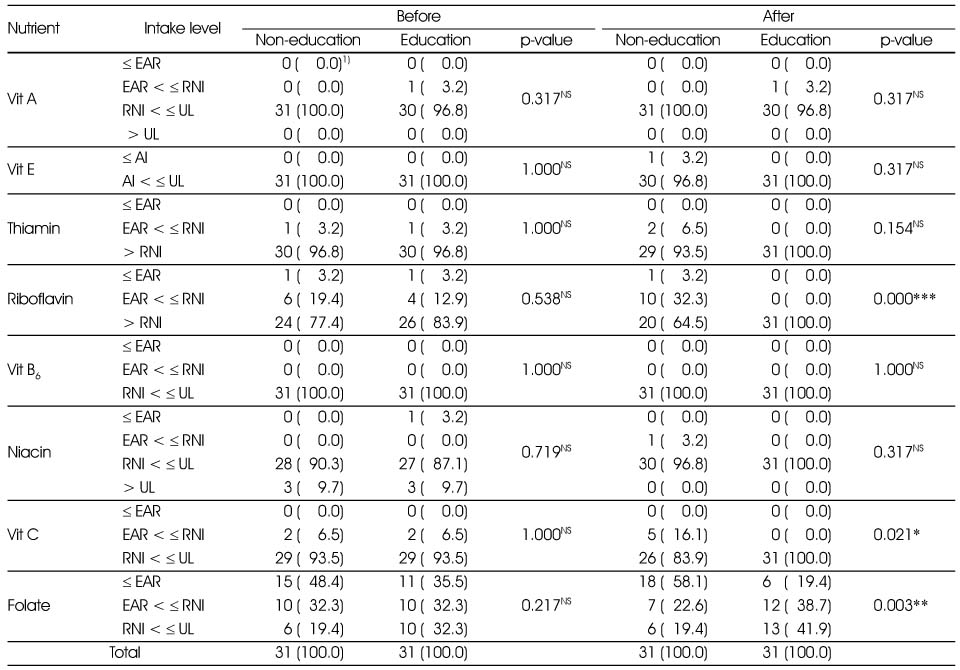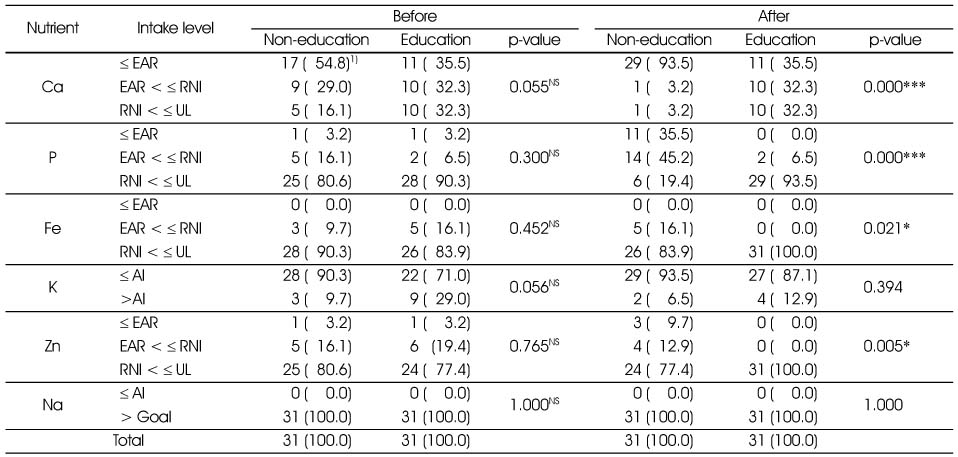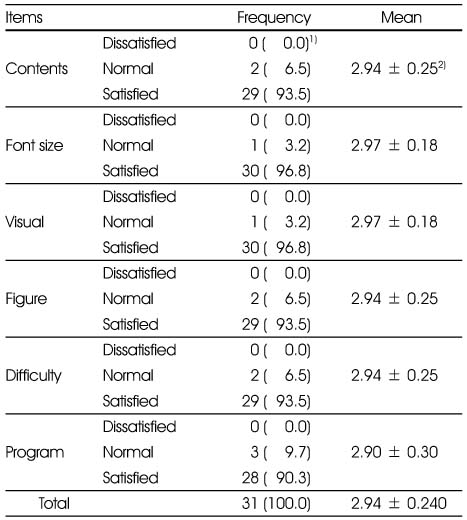References
1. Choi JY. Effect of dietary life education program on nutrition knowledge and eating habit of elementary school third grade student 2009. Cheongju National University; MS thesis.
2. Choi MK, Lee YS, Lee YS, Bae YJ, Kim MH, Lee YS, Kim AJ, Sung CJ. Evaluation of nutritional health camp in obese elementary students. Korean J Food Nutr 2007. 2079–87.
3. Hong JK. A study on the professional guidance and counseling for children in elementary school. J Elementary Educ 2002. 15(1)1–20.
4. Hong SY. Basic Statistics 2004. Seoul: Hakjisa;
5. Hur ES. Development of practical dietary education textbook and teaching manual in elementary school students. Korean J Community Nutr 2010. 15(5)636–647.
6. Jun JH. Effects of nutrition education on children with an unbalanced diet 2001. University of Incheon; MS thesis.
7. Kim BH, Sung MY, Lee YN. Comparison of the nutrient intakes by the score of dietary action guides for Korean children among the elementary school students in Gwangju city. Korean J Community Nutr 2011. 16(4)411–425.
8. Jung IK. A Study on perception of teachers on the nutrition education in elementary school curriculum. J Korean Home Econ Educ Assoc 2005. 17(4)73–85.
9. Kim GM, Lee SY. The study on nutritional knowledge and eating behavior of elementary school senior students in Incheon area. J Korean Diet Assoc 2000. 6(2)97–107.
10. Kim JY, Han YS, Bae HY, Ahn HS. Dietary intakes and serum lipids and iron indices in obese children. Korean J Community Nutr 2006. 11(5)575–586.
11. Kim SB, Choi HJ. Effects of nutrition education using Food Exchange System: changes in elementary students' nutrition knowledge, dietary attitude and nutrients intake. Korean J Community Nutr 2008. 13(6)922–933.
12. Kim SH. Children's growth and school performance in relation to breakfast. J Korean Diet Assoc 1999. 5(2)215–224.
13. Kim YH, Ju HO. Elementary schoolers' skipping breakfast. Korean J Child Health Nurs 2004. 10(4)488–495.
14. Kyeon YK, Jang YA, Kim JW. Application of a practical nutrition education program, KHIDI KIDS, for the improvement of dietary attitudes and habits of elementary students. Korean J Nutr 2006. 39(8)808–816.
15. Lee JE, Jung IK. A study on eating habits of elementary school students and the perception on the nutrition education in curriculum. J Korean Home Econ Educ Assoc 2005. 17(2)79–93.
16. Lee KA. Activity-based nutrition education for elementary school students. Korean J Food Nutr 2003. 36(4)405–417.
17. Lee MJ, Jang MS, Lee JM. Analysis of recognized changes in performance and organizational environment by dietitians transposed to nutrition teachers in Gyeonggi province. J Korean Diet Assoc 2008. 14(3)243–258.
18. Lee YM, Lee MJ, Kim SY. Effects of nutrition education through discretional activities in elementary school -Focused on improving nutrition knowledge and dietary habits in 4th-, 5th- and 6th-grade students-. J Korean Diet Assoc 2005a. 11(3)331–340.
19. Lee YS, Lim HS, Ahn HS, Chang NS. Nutrition throughout the life cycle 2005b. Paju: Kyomunsa;
20. Moon HN, Hong SJ, Shu SJ. The prevalence of obesity in children and adolescents. Korean J Food Nutr 1992. 25(5)413–418.
21. Mun YS, Jung EK, Yoon JY. A study on the intakes and perceptions of convenient breakfast. Korean J Community Nutr 2011. 16(5)559–568.
22. Park HS. Relation between obesity index and dietary pattern of 4-6 graders in Jeonbuk 2006. Chonbuk National University; MS thesis.
23. Park YS, Lee JW, Seo JS, Lee BK, Lee HS. Nutrition education and counseling 2010. Paju: Kyomunsa;
24. Rural Development Administration. The Korean Community Nutrition Society. Children's Nutrition Guide 2009. Paju: Kyomunsa;
25. Shim JE, Paik HY, Moon HK. Breakfast consumption pattern, diet quality and health outcomes in adults from 2001 National Health and Nutrition Survey. Korean J Nutr 2007. 40(5)451–462.
26. Shin EK, Lee HS, Lee YK. Effect of nutrition education program in obese children and their parents(I), focus on anthropometric values and serum biochemical index. Korean J Community Nutr 2004. 9(5)566–577.
27. Son HS, Lee YK. Development and evaluation of an elementary school nutrition education program to prevent breakfast skipping. Korean J Community Nutr 2010. 15(6)740–749.
28. Son SM, Lee KH, Kim KY, Lee YN. Practices in nutrition education and counseling 2007. Seoul: Life Science Publishing Co.;
29. Trumbo P, Schlicker S, Yates AA, Poos M. Dietary reference intakes for energy, carbohydrate, fiber, fat, fatty acids, cholesterol, protein and amino acids. J Am Diet Assoc 2002. 102(11)1621–1630.
30. The Korean Nutrition Society. Dietary reference intakes for Koreans 2010. Seoul: Han-Arum Publishing Co;
31. Yang IS, Chung HK, Chang MJ, Cha JA, Lee SJ, Chung LN, Park SH, Cha SM. Development of the educational program for Korean traditional food culture for the elementary students. Korean J Food Nutr 2006. 12(2)127–145.
32. Busan National University of Education, Department of Practical Arts Education. Playing food tower with Toto 2010. cited 2010 August 10. Available from
http://www.foodtower.net/.
33. Changwon National University, Department of Food and Nutrition. Jjang & food friend 2010. cited 2010 August 10. Available from
http://www.food79.net/.
34. Chungbuk National University, Applied Nutrition Laboratory. I Food 2010. cited 2010 August 10. Available from
http://ifood.or.kr/.



